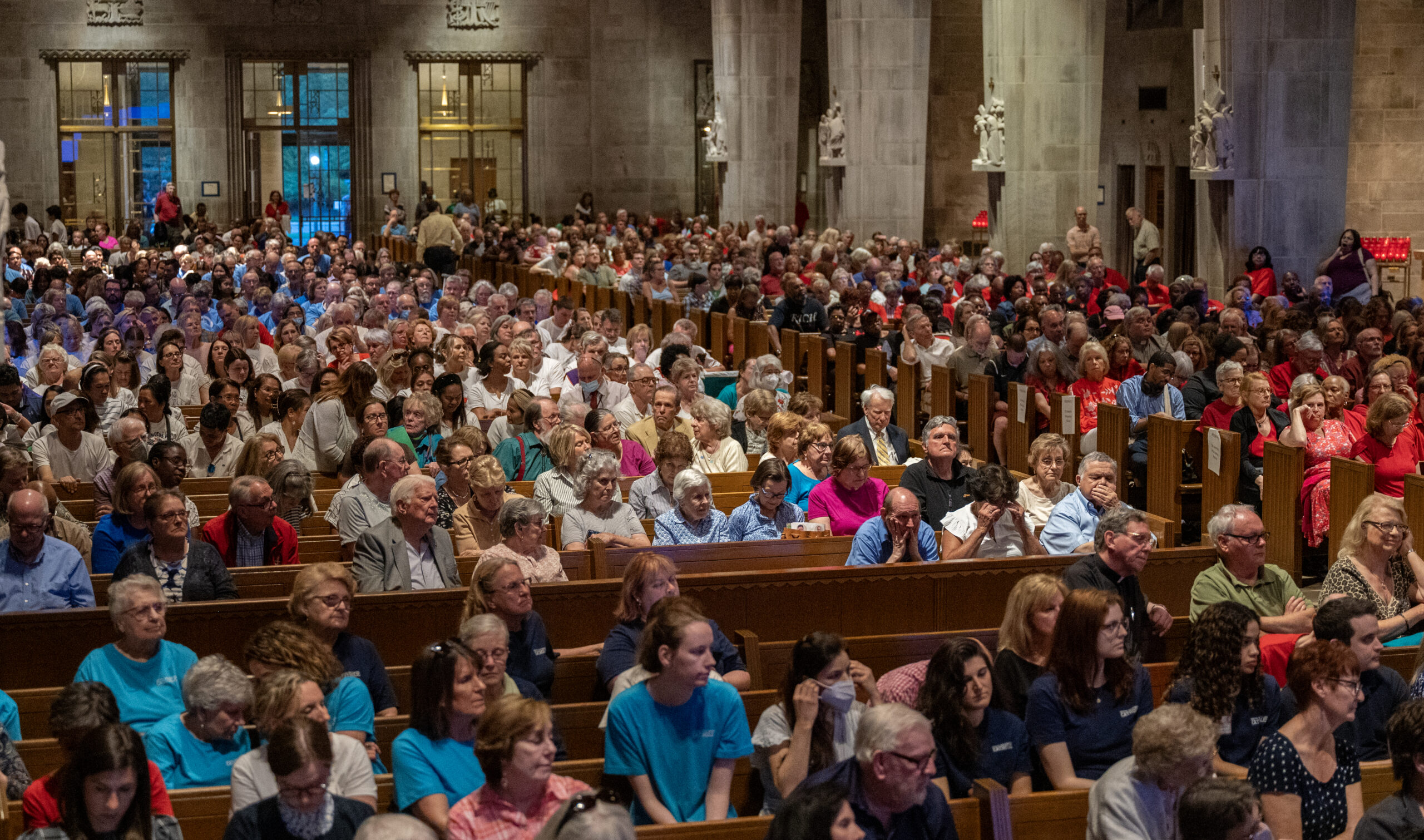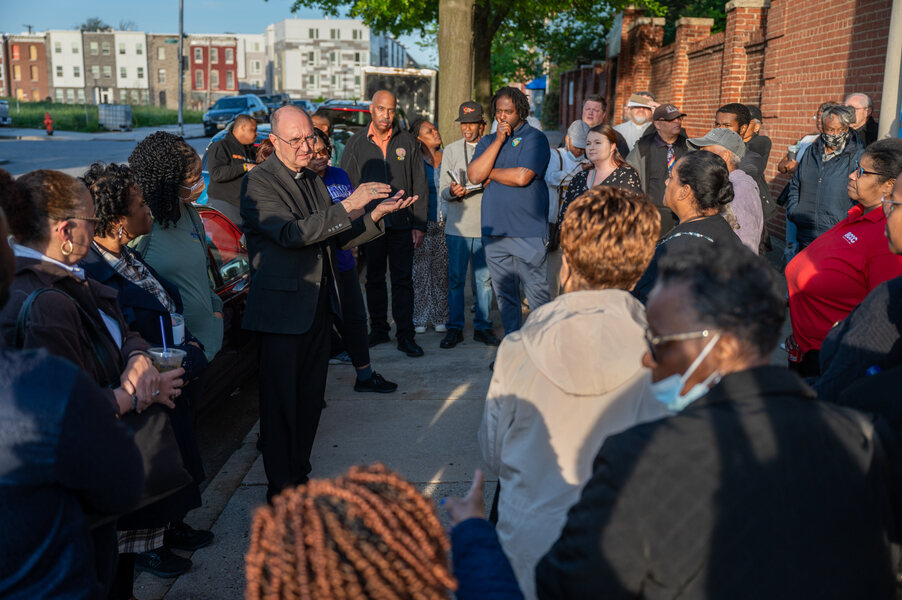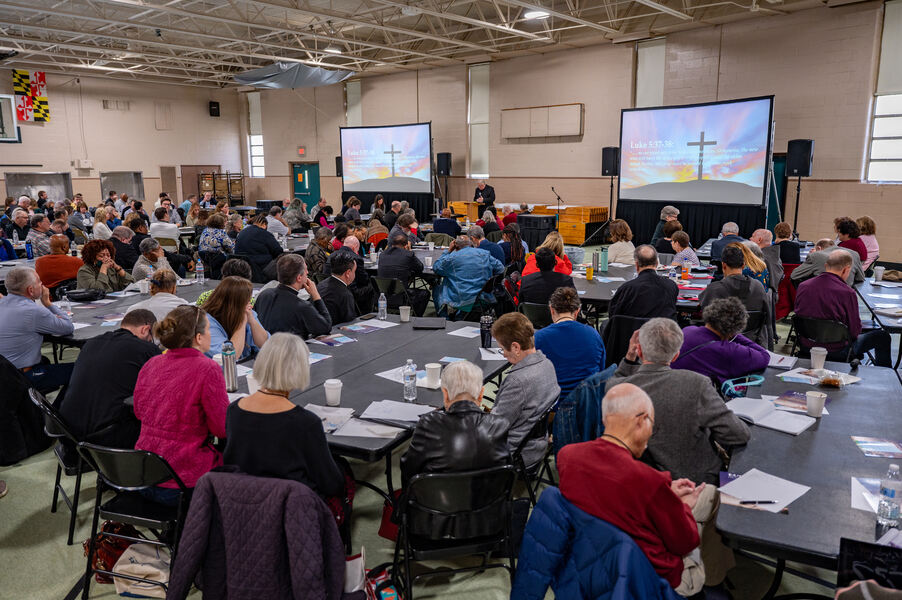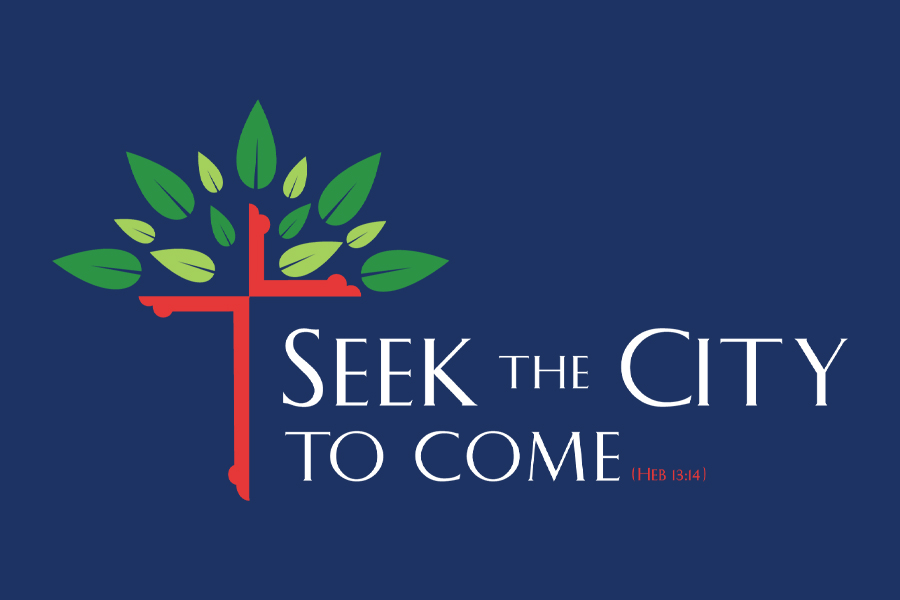A steady stream of people was still flowing into Archbishop Curley High School more than 20 minutes after an April 25 listening session on the Archdiocese of Baltimore’s Seek the City to Come parish reconfiguration proposal officially started.
So many people showed up – estimated at more than 1,200 – that they had to be split between the Baltimore school’s cafeteria and its nearby auditorium. Hundreds more were watching a livestream online at home.
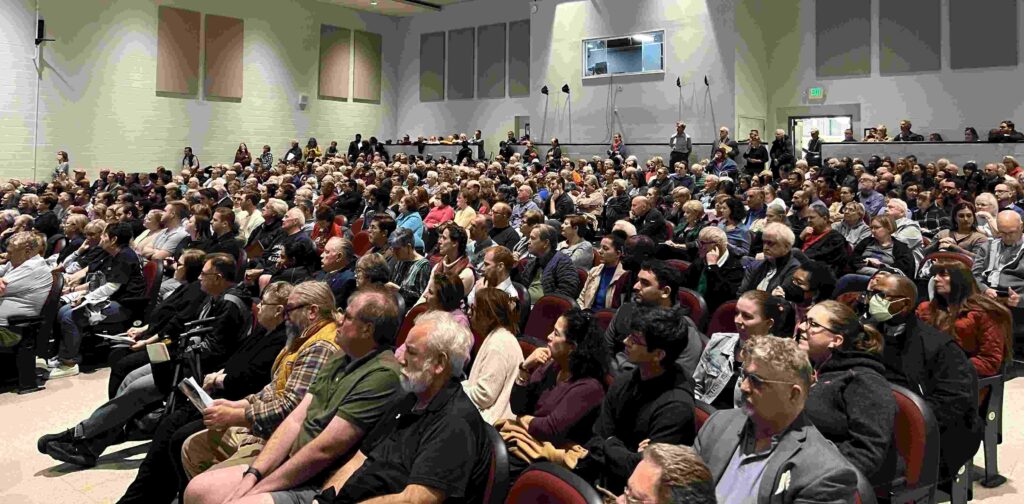
Impassioned speakers encompassing parishes from all parts of the city, as well as Dundalk, Essex, Edgemere, Catonsville and Arbutus, took to microphones to express their hopes, concerns and suggestions about a plan that would reduce the number of worship sites in Baltimore City and some parts of Baltimore County from 59 to 26 and the number of area parishes from 61 to 21.
Auxiliary Bishop Bruce A. Lewandowski, C.Ss.R., vicar for Baltimore City and co-director of Seek the City, began the three-hour meeting with a prayer and outlined why change is needed in the way the church operates in the city and nearby suburbs.
“It’s getting progressively harder to do more with less,” Bishop Lewandowski said, noting that the city population has declined 38 percent since 1950.
The bishop said many parish buildings in the city are old, with high maintenance costs. Some of the boilers are 80 years old, he said, and wiring in many churches dates to the 1940 and 1950s. Although the churches combined can accommodate 25,000 people for a single Mass, Seek the City data shows that only about 2,500 people go to Mass on the weekend among the parishes in the city. Many parishes have more funerals than baptisms.
“It’s not sustainable,” Bishop Lewandowski said.
The Seek the City process, which began two years ago and has included the input of more than 3,800 people over the course of several visioning and planning sessions, is designed to be what the bishop called a “fresh start.”
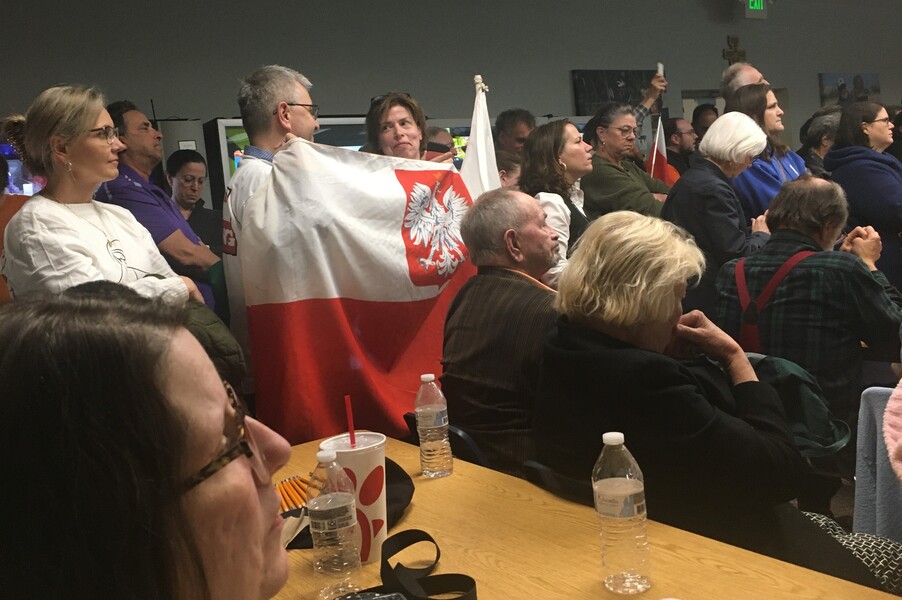
Bishop Lewandowski said the days of parishes competing among themselves for parishioners are over.
“We can’t do that anymore,” he insisted. “We need to start going after the unchurched. We want to take care of the good Catholic people we have already, but we want to cast out … and reach into the neighborhoods and share the Gospel.”
Geri Royale Byrd, co-director of the Seek the City initiative, repeatedly emphasized that the proposal on parish reorganization and revitalization is not final. The archdiocese is holding listening sessions to get feedback that will be used as Archbishop William E. Lori discerns the final plan. That plan is expected to be announced in June.
A listening session for Black Catholics was held April 23 at St. Frances Academy in Baltimore. A session for Spanish-speaking Catholics is set for 7 p.m. April 29 at Our Lady of Fatima in Baltimore and a final session will be held at 6:30 p.m. April 30 at the Cathedral of Mary Our Queen in Homeland.
All the listening sessions are being recorded and documented, Byrd said.
“We want to hear your constructive feedback,” she said.
Many parishioners at the Curley session spoke about the ways their parishes anchor their communities. They expressed concerns about how closing some of those buildings will affect parts of the city that are already struggling. Some said more support is needed for city parishes from wealthier faith communities in the county.
“We do not have the luxury to get this wrong,” said James Conway, a parishioner of St. Wenceslaus in East Baltimore, a church that would be combined with nearby St. Ann and St. Francis Xavier at St. Francis Xavier’s campus.
Conway said the spirit of God cannot be diminished and that 21 parishes with 26 worship sites is not enough. While he said he had “no problem” going into other churches, he called St. Wenceslaus his home.
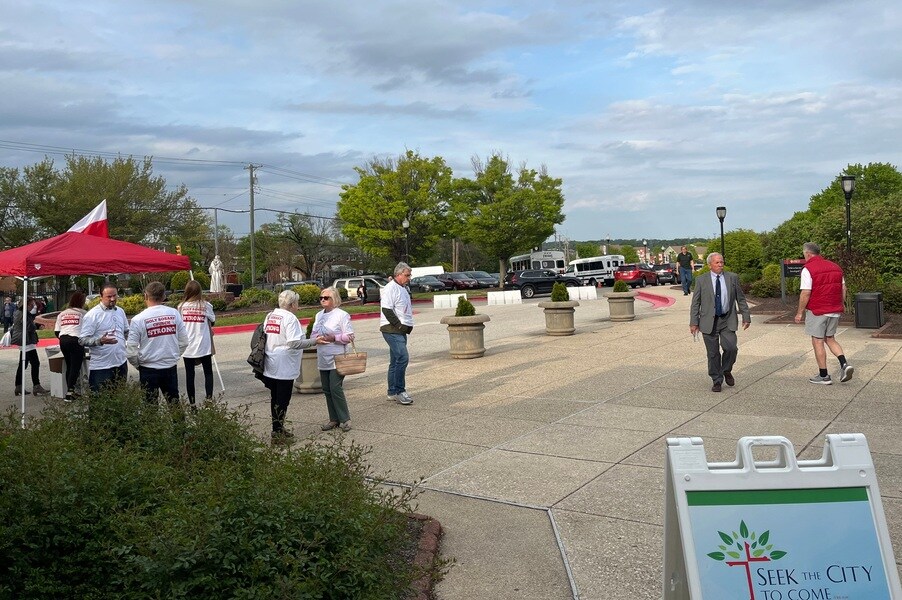
“You can’t ask me to make a home a place that’s not home,” he said. “Our spiritual journeys drag and draw us to where we belong so that we can grow our spiritual gifts. Once we grow our spiritual gifts, then we can go out into the community and give the fruits of our gifts to our communities so that we can bring others in.”
Conway questioned why there was not a “combined fundraiser” to try to keep the churches open. Other speakers suggested that the archdiocese sell its administrative headquarters, the Catholic Center, and use the money to support the parishes.
Speakers from St. Thomas More in Northeast Baltimore and Shrine of the Sacred Heart in Mount Washington noted that their communities serve Filipino and African immigrant communities, calling it vital that they remain open in a spirit of welcome.
Speakers from Corpus Christi in Bolton Hill, which would be combined with Ss. Philip and James in Homewood at Ss. Philip and James, said their church was unique because of its ministry to the LGBT community. They emphasized the need for members of that community to be welcomed if they have to move to a different worship site.
Parishioners of St. Luke in Edgemere noted that their parish is on a peninsula with one way in and out. They said they worried about how outreach efforts, including a food pantry and two Narcotics Anonymous groups, would continue. St. Luke would join with St. Rita in Dundalk, Sacred Heart of Mary in Graceland Park and Our Lady of Hope in Dundalk at Our Lady of Hope.
A parishioner of St. Clare in Essex, which would be combined with Our Lady of Mount Carmel at the Mount Carmel campus, noted that the new location for the combined parish has fewer parking spots than St. Clare and limited space in its buildings. She wondered how combined ministries and programs could be accommodated. The parishioner also said Catholic churches need to look to the example of “megachurches” that are making efforts at reaching out to young people in ways the Catholic Church is not.
“We do nothing for our children,” she said. “The megachurches know how to do it. It’s not impossible.”
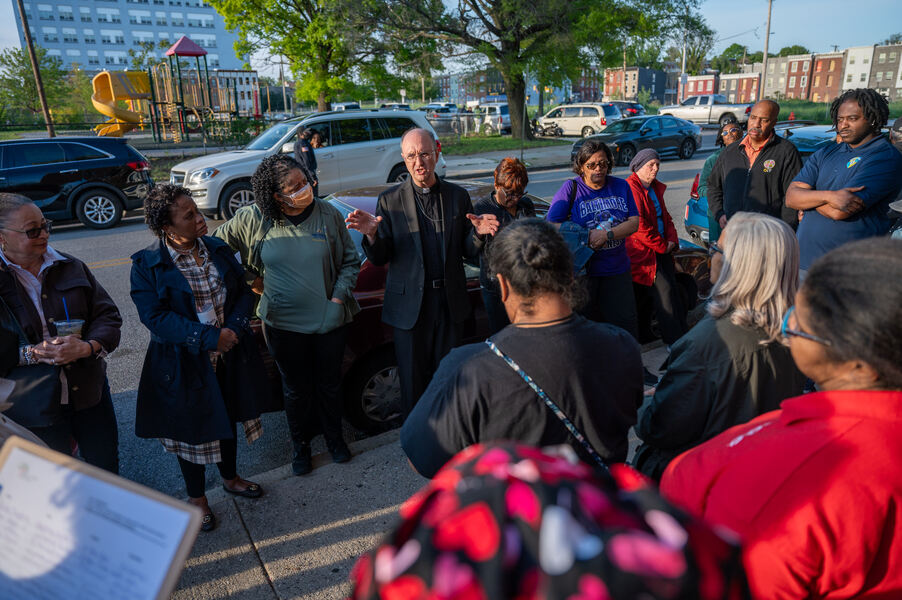
Several speakers raised objections to closing church locations where there is a parish school, with one noting that it sends the wrong message to the wider community.
Under the proposal, St. Francis of Assisi (which has a school) would be combined with Blessed Sacrament, Most Precious Blood, Shrine of the Little Flower, St. Anthony of Padua, St. Dominic, St. Mary of the Assumption and St. Matthew at St. Matthew. The school would remain open.
Geri Sicola, president of the pastoral council at St. Vincent de Paul Parish in Baltimore, acknowledged that reconfiguring parishes is necessary. She encouraged the archdiocese to think broadly about the kinds of communities that can come together – not just based on geography, but also shared charisms.
“We know we have to change,” she said. “We know we have to grow.”
Darlene Thomas, a parishioner of St. Francis Xavier in East Baltimore, the first Black Catholic parish in the country, reminded those gathered that Baltimore has a history of racism. Many Black Catholics have not been accepted at white churches, she said.
Lisa Mary O’Reilly, who lives near Blessed Sacrament in Baltimore and who has served in pastoral ministry at several Baltimore parishes, said the archdiocese will need to develop plans for the pastoral care of parishioners who will be traumatized by the loss of their parishes and the coming together of new communities.
“It’s like bringing a divorced family together,” she said.
Prior to the start of the listening session, a large group of parishioners from Holy Rosary in Fells Point, which serves the Polish community, stood and sang the Polish national anthem while waving Polish flags emblazoned with the Polish eagle. Some wore shirts saying “Holy Rosary Strong.”
Under the Seek the City proposal, Holy Rosary would combine with Sacred Heart of Jesus-Sagrado Corazón de Jesús in Highlandtown and Our Lady of Pompei in Highlandtown (with the new parish to be based at Sacred Heart of Jesus), but Holy Rosary would remain open as a site for Polish and Hispanic ministry.
Speakers from the parish said they are open to Hispanic ministry, but wanted Holy Rosary to remain independent and under the leadership of the Society of Christ, a Polish religious order. They said it is important the archdiocesan Shrine of Divine Mercy, located at the parish, remain open.
Rich Olkowski, a deacon candidate from St. Michael in Overlea, told the Catholic Review that the large gathering at Curley “shows the passion people have for their Catholic faith.
“I hope we can continue this enthusiasm and fill our churches,” he said.
For more information about the Seek the City proposal, visit seekthecity.org
Gerry Jackson contributed to this story.
Email George Matysek@CatholicReview.org
Read More Seek the City to Come
Copyright © 2024 Catholic Review Media

